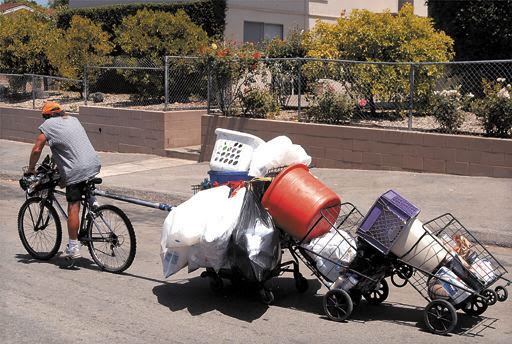Discarded Treasures
Will We Make Homeless Residents Lose Their Most Precious Belongings?

If he hadn’t learned to live as a cliff dweller, he might have been riding up State Street with a bike and trailer overflowing with the items he collected from various dumpsters through the city. He might have lost his “treasures” to a new ordinance under consideration by a reactive city council which allows personal items left unattended for more than four hours to be confiscated and items valued under $100 to be discarded, treasures back into the dumpsters. Councilmember Kristen Sneddon was the only one on the Ordinance Committee to vote against this heartless measure.
Living inside the brain of a person with schizophrenia is like a minefield maze. He is a collector. My relative has been housed in every way possible: jail, hospital, ER, single-unit apartment, and a closet in his son’s home, but outdoors is where he ultimately ends up. When the “aliens” torment him, he yells back. Neighbors hear him through the walls. His torment is unbearable for all who listen.
Being homeless in Santa Barbara requires some street sense and skill. He had trouble getting along with his outdoor neighbors. He showed up one day with a bump on his forehead from a nearby camper who threw a bottle at him when he raged back at the voices in his mind. This is why he ended up dwelling on cliffs. No one wants to listen to the midnight rantings of a person tormented with voices. “I’m taking food to my little friends” — without human friends, he made friends with the critters, feeding the birds and gophers who came near his site. He finally found a medication without dulling side effects, which allowed him to sleep through the night. But the ups and downs of relapse and psychotic symptoms still plagued him. No one on drugs remembers to take psychiatric medication. That’s a well-known fact.
It might surprise readers to learn that this man was also a husband, a father of two sons. He got his photo in the Independent one year for being an environmental hero as he rode a bike with three trailers attached full of bottles and cans on the way to the recycling center. He drove to Santa Barbara after experiencing his first psychotic episode while serving in the U.S. Army. While he couldn’t live with his family due to the severity of his illness, he did bring them things. Little things, big things, sometimes it was too many things. Like many who suffer serious mental illness, he collected many things. The discombobulation of his belongings made sense in his unstructured mind.
One year, I saw him riding his bike down from the Mesa with one hand on the handlebar and the other holding a 5-foot Christmas tree on his back that he was bringing to his boys. His gentle spirit and huge heart are amazing. This man, whom a passerby might just see as “a hopeless addict,” “a schizophrenic,” a homeless person who causes a nuisance for merchants and pedestrians alike, is one of us. There is no difference between myself and a person with mental illness or addiction other than genetics and financial advantage. Yet we, the residents of Santa Barbara, are considering letting these residents lose their most precious belongings just because they create a sense of disorder which may require walking around them. My anger and heartbreak are held closely in check as I write.
This man whose belongings we would confiscate took care of his wife and her two young children from the time she was diagnosed with cancer until the day five years later when she died. He cooked and he cleaned. He didn’t function well in the “normal” way, but he was there during the hardest of times. When she died, he drowned his sorrows in a bottle of tequila and yelled at me, and I understood. I was in shock, but part of me wished I could also crawl inside a bottle to shout and drown such profound loss. He even made it two years after her death before he had a serious relapse again, which led back to homelessness.
Forty years since my relative first moved here, Santa Barbara finally has funds for “housing first” and other programs to repair a mental-health system that has been plagued by gaps. The remedy is a comprehensive and coordinated continuum of care that includes creating good relationships with neighbors as small programs are integrated in communities. “I don’t understand where these people are supposed to go or what they’re supposed to do,” Councilmember Kristen Sneddon stated. Why can’t the city simply invest in storage lockers to locate behind businesses for just one person to use at each site? We can do it for food to keep bears out of campsites. Why can’t we do it for community members who have not yet found the resources or remedies for the disabilities that plague them?
People don’t choose to be homeless. Economics, unemployment, and disabling conditions are the forces that bring them to such traumatic circumstances. Each person, myself included, has a story untold.



